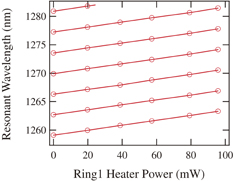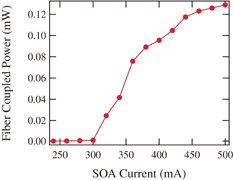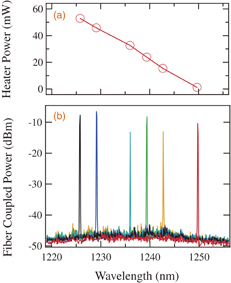Abstract
Compact, wavelength-tunable light sources are desired for the enhancement of information communication technology and bio-imaging applications. We propose a compact, wavelength-tunable laser diode with a wide wavelength-tunable range around 1230 nm consisting of a quantum-dot optical amplifier and a silicon photonic tunable filter. High-quality InAs quantum dots grown with the sandwiched sub-nano separator technique were used as the optical gain medium. The wavelength-tunable filter was constructed with ring resonators fabricated using silicon photonics. The single-mode laser oscillation was demonstrated with a 28.5-nm wavelength-tunable range.
Export citation and abstract BibTeX RIS
Recent advances in information and communication technology are expected to facilitate increased traffic and enhanced optical transmission. High-capacity optical transmission systems are based on wavelength-division multiplexing systems with dense frequency channels. Compact, low-power-consumption, and high-spectral-efficiency broadband photonic devices are required for large-capacity optical communication systems that use wide optical-frequency channels.1,2) Quantum-dot (QD) optical gain media have various attractive characteristics for light source applications, such as an ultra-broad optical gain bandwidth, high-temperature device stability, and a small linewidth enhancement factor.3–8) In addition, the lower optical absorption of near-infra-red light with a wavelength around 1.3 µm due to water is particularly useful for light sources used in biomedical imaging applications, such as optical coherent tomography.9,10) A wavelength-tunable QD laser with a wide wavelength range has been demonstrated using a diffraction grating in free space.11) The realization of a compact wavelength-tunable light source using QD technology is desired for information communication technology and bio-imaging applications. On the other hand, silicon photonic wire waveguides based on the silicon-on-insulator structure provide a promising platform for highly integrated photonic devices. In addition, silicon photonic devices can be fabricated by the mature fabrication technologies for electric integrated circuits.12–20) Recently, very compact and narrow-spectral-linewidth laser diodes with a wavelength-tunable range around 1550 nm have been demonstrated using silicon photonic wire ring resonators and a commercially available quantum well semiconductor optical amplifier (SOA).21–23) In this letter, we propose a compact wavelength-tunable laser diode constructed with a QD optical-gain chip and a silicon photonic external cavity. To our knowledge, this is the first demonstration of a wavelength-tunable laser diode combining QD and silicon photonics technologies. The silicon photonic wavelength-tunable laser diode with QD will provide new applications of silicon photonics technologies.
Figure 1 shows the schematic of the wavelength-tunable laser diode. The tunable laser consists of a QD-SOA chip to provide optical gain and a silicon photonic chip with ring resonators to select the lasing wavelength. The QD-SOA optical gain medium was grown by molecular beam epitaxy on an n-type (001) GaAs substrate. The sandwiched sub-nano separator (SSNS) growth technique was used to obtain high-quality and high-density self-assembled InAs QDs,24) as shown in the atomic force microscope (AFM) image in the inset of Fig. 1. An SSNS layer consisting of a 3.0 ML GaAs thin film was deposited on a 10 ML In0.15Ga0.85As quantum well to compensate the lattice strain due to lattice mismatch. Then, capping layers of 2.16 ML InAs QDs and 24 or 28 ML In0.15Ga0.85As were grown. The growth sequence described above was repeated 7 times. A 2-mm-long and 3-µm-wide ridge waveguide SOA containing the ultra-broadband InAs QD gain medium was fabricated. An anti-refraction (AR) coating was fabricated on the one side of the end facet to connect the silicon photonic external cavity without reflection. A cleaved facet mirror with 30% reflectivity was formed on the other side of the end facet. The amplified spontaneous emission (ASE) spectra of the InAs QD-SOA with various injection currents are shown in Fig. 2. The center wavelength of the ASE spectra is approximately 1230 nm in the T-band (thousand band: 1000–1260 nm). No lasing oscillation was observed owing to the AR coating of the end facet.
Fig. 1. Schematic of the wavelength-tunable laser with a QD SOA and a silicon photonic external cavity. The inset is an AFM image of QDs grown by the SSNS technique.
Download figure:
Standard image High-resolution imageFig. 2. Measured amplified spontaneous emission of the QD-SOA with various SOA injection currents.
Download figure:
Standard image High-resolution imageA silicon photonic external cavity with a wavelength filter was fabricated using a CMOS-compatible process. Figure 3 shows a top view of the fabricated silicon photonic chip. A loop-type wavelength filter with two ring resonators was formed using a 400-nm-wide and 220-nm-high silicon photonic wire waveguide shown in the inset of Fig. 3. Although this waveguide did not satisfy the single-mode condition near the 1230 nm wavelength, the higher-order modes can be ignored because they involve large bending losses in ring resonators with small radii. The light from an SOA or optical fibers was coupled to a silicon waveguide with a high coupling coefficient through a double-core spot size converter.25) The propagating light was filtered by two ring resonators with different free spectral ranges (FSRs). Light with a specific wavelength, selected on the basis of the Vernier effect between the two ring resonators, was reflected to the input port.26–29) The circumferences of the two ring resonators were 101 µm (ring 1) and 92.9 µm (ring 2), and the power coupling efficiency of the directional coupler between the bus waveguide and the ring resonator was designed to be 0.15 around the wavelength of 1250 nm. The small power coupling efficiency augmented the transmittance difference between the selected wavelength and the neighboring side-mode. This filter was designed to provide an efficient transmittance difference of 8 dB for the wavelength tuning operation. The selected wavelength was tuned through the thermo-optic (TO) effect of silicon30–32) using 100-nm-thick tantalum micro-heaters placed on the ring resonators. The silicon photonic chip performed as a wavelength-tunable filter and the external laser cavity. The resonant wavelengths of the ring resonators were measured with an O-band super luminescent diode as the light source. The measured spectra of the transmitted light from ports 1 and 2 are shown in Fig. 4. The peak wavelengths of port 1 correspond to the resonant wavelengths of ring 2, and the peaks of port 2 correspond to the resonant wavelengths of ring 1. From this measurement, the FSR of ring 1 was found to be 672 GHz, and that of ring 2 was 731 GHz. The Q factors of the ring resonators were approximately 9000. The wavelength-tuning range of this filter was estimated as 44.0 nm. Figure 5 shows the heating power dependences of the resonant wavelengths of ring 1, where the displayed power is the effective heating power after subtracting the power consumption of the wiring electrodes. These are linearly shifted to longer wavelengths by heating with the micro-heater because the effective circumference of the ring resonator is lengthened by the large positive TO coefficient of silicon. The transmittance of the silicon photonic external cavity was maximized when the resonant wavelength of one ring resonator was coincident with the resonant wavelength of the other ring resonator. The footprint of the external filter was smaller than 0.6 × 1.5 mm2 including the electrode pads. Therefore, we have achieved the realization of a very compact external cavity for wavelength-tunable laser diodes by using silicon photonics technology.
Fig. 3. Microscope image of the fabricated silicon photonic wavelength filter with Ta micro-heaters. The inset shows the configuration of the ring resonators in the wavelength filter.
Download figure:
Standard image High-resolution imageFig. 4. Transmittance spectra from port 1 and port 2.
Download figure:
Standard image High-resolution imageFig. 5. Dependence of the ring 1 heater input power on the resonant wavelengths.
Download figure:
Standard image High-resolution imageThe QD-SOA and the silicon photonic external cavity were butt-jointed using stepping-motor-controlled stages. The temperature of the SOA was stabilized at approximately 25 °C by a thermo-electric cooler. The laser output from the cleaved facet of the QD-SOA was measured using a lensed fiber. The SOA injection current dependence of the optical output power is shown in Fig. 6. The threshold current of the laser oscillation was 300 mA and the maximum fiber-coupled output power was 0.128 mW when the QD-SOA injection current was 500 mA. Figure 7 shows the lasing spectrum around the 1230 nm wavelength when the SOA injection current was 400 mA. A clear single-mode laser oscillation with a 47 dB side-mode suppression ratio (SMSR) was observed. The lasing wavelength-tuning operation was performed using a micro-heater placed on ring 1. Figure 8(b) shows the superimposed lasing spectra when ring 1 was heated. The relationship between the heater input power and the lasing wavelength is shown in Fig. 8(a). The lasing wavelength was linearly tuned by the heater input power, and a 23.9-nm wavelength tuning range was obtained with a 32-dB SMSR between the ring resonator's modes. Nevertheless, the lasing wavelength spacing corresponds to the FSR of the unheated ring 2 (731 GHz), whereas the two lasing modes around 1232 and 1246 nm were unfortunately not observed. Because longitudinal modes with a 150 pm wavelength spacing also exist in this laser cavity, the transmittance of the external cavity is the product of the transmittance of the ring filter and that of the longitudinal mode. Although the output powers are maximized when the resonant wavelength of the ring resonators coincides with the peak wavelength of the longitudinal mode, they decrease in non-coincident cases, and, in the worst case, the lasing oscillation is inhibited. The reduction of the transmittance is decreased by using low-Q factor rings. Figure 9 shows the lasing wavelength spectra of a laser with low-Q factor rings, which were realized by using directional couplers of 0.2 coupling efficiency between the ring resonator and the bus-waveguide. The ring resonators were designed to have a Q factor of 5000 and a transmittance difference of 5.5 dB between the selected wavelength and the neighboring side mode. A satisfactory wavelength tuning operation was observed with a 28.5 nm wavelength tuning range. Although the output powers depend on the wavelength because of the influence of the longitudinal modes, the power variation can be improved by using an additional phase shifter for the longitudinal modes. The wavelength-tuning operation was performed using a micro-heater with 2.1 mW/nm power consumption. The obtained tuning range around a wavelength of 1230 nm corresponds to a 5.7 THz tuning range, which is larger than the C-band (4.4 THz) in the frequency domain. The compact and high-frequency efficiency tunable laser diode consisting of a 0.6 × 1.5 mm2 footprint silicon photonic external cavity and a 2-mm-long QD-SOA was thus demonstrated.
Fig. 6. Dependence of the optical output power of the wavelength-tunable laser on the injection current.
Download figure:
Standard image High-resolution imageFig. 7. Lasing spectrum for 400 mA QD-SOA injection current.
Download figure:
Standard image High-resolution imageFig. 8. (a) Heating power of ring 1 for tuning the lasing wavelength. (b) Superimposed lasing spectra for a QD-SOA injection current of 400 mA.
Download figure:
Standard image High-resolution imageFig. 9. Wavelength tuning operation of the improved wavelength filter with low-Q factor ring resonators. (a) Heating power of ring 1. (b) Superimposed lasing spectra for a QD-SOA injection current of 400 mA.
Download figure:
Standard image High-resolution imageA wavelength-tunable laser diode with an InAs QD optical amplifier and a silicon photonic external cavity was studied, and clear single-mode lasing operation with a wide wavelength tuning range of 28.5 nm was successfully demonstrated. We expect that the combination of the QD technique and silicon photonics will provide a breakthrough technology for the development of effective and compact light sources.
Acknowledgments
This research is supported by Strategic Information and Communications R&D Promotion Program (SCOPE), Ministry of Internal Affairs and Communications, Japan, and Grants-in-Aid for Scientific Research (25420312), JSPS. The authors thank the staff of Pioneer Micro Technology Corporation.










